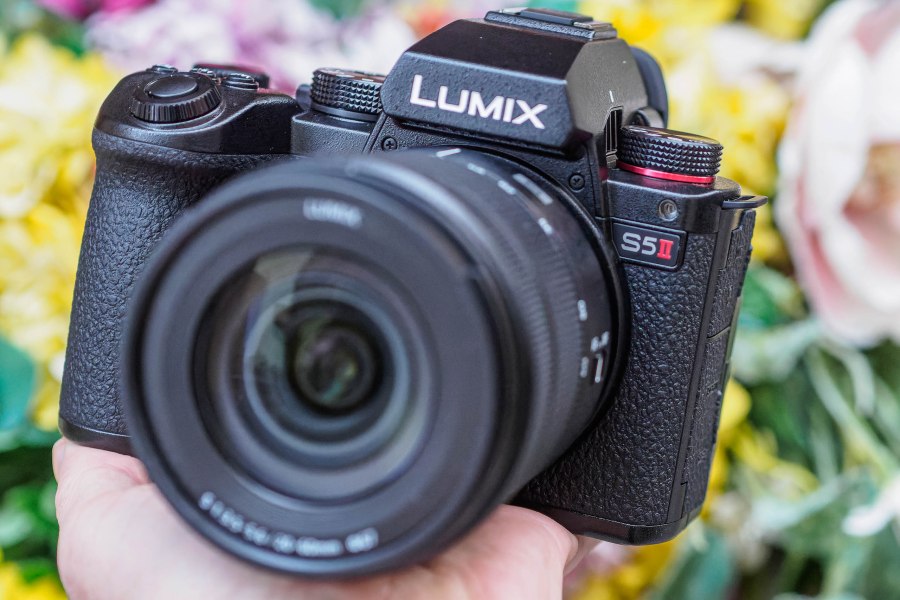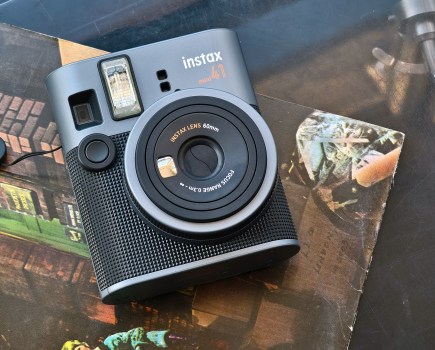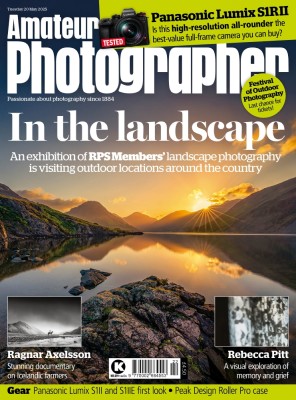This is our full, complete rundown of the best cameras for vlogging that we’ve tested. To create video that looks and sounds professional, a dedicated vlogging camera is essential. And while many people vlog on smartphones, their basic physical limitations (think sensor size and lens choice) ultimately inhibit the quality of production and user experience. Cameras have advantages of handling, versatility, features, and video quality that set them apart.
The following list is based on the findings of our reviews, where we put some of the best mirrorless cameras and best action cameras through their paces. Our full camera testing process includes assessing video capability, and as such this list only includes cameras that have impressed our team with the quality of their video and ease of use. We’ve included plenty of cheap and user-friendly options as well as the high-end stuff, so anyone looking for their first vlogging camera will find something here.
For more beginner vlogging tips, take a read of our guide to making a video for YouTube. We also have a handy guide to how to get started with vlogging.
For the best deals on the best vlogging cameras for video and YouTube, look no further. Our ‘Buy now’ buttons are set up to automatically take you to the best prices from trusted retailers. There’s also a list of other retailers below each camera, so you can find the right deal for you.
- Best vlogging camera overall: DJI Osmo Pocket 3 – Buy now
- Best compact for vlogging: Sony ZV-1 Mark II – Buy now
- Best hybrid stills and video camera for enthusiasts: Fujifilm X-M5 – Buy now
- Best mid-range 4K camera: Sony ZV-E10 II – Buy now
- Best 4K Micro Four Thirds camera: Panasonic Lumix GH7 – Buy now
- Best cheap vlogging camera: Canon PowerShot V10 – Buy now
- Best for action and adventure: DJI Osmo Action 5 Pro – Buy now
- Best full-frame video camera for 4K: Panasonic Lumix S5 II – Buy now
- Best for camera for filmmaking: Blackmagic Pocket Cinema 4K – Buy now
- Best video camera for beginner YouTubers: Nikon Z30 – Buy now
- Best weather sealed compact mirrorless camera: Olympus OM System OM-5 – Buy now
- Best Canon APS-C camera: Canon EOS R10 – Buy now
Why you can trust Amateur Photographer…
We spend many hours testing every product we recommend, in detail, in a variety of situations and shooting scenarios, and only use experts for our reviews, so you can be sure that you’re getting the best products. Find out more about our expert writers.
Best overall
Best vlogging camera overall: DJI Pocket 3

Amateur Photographer verdict
With a better screen and bigger sensor, DJI’s slimline gimbal camera remains a unique proposition in the vlogging space, offering excellent value for money even after a price hike.- Powerful built-in stabiliser
- Big, useful screen
- Easy to shoot in portrait mode
- Big price increase from Pocket 2
- No built-in storage
Specifications at a glance:
| Camera type | Vlogging camera with gimbal |
| Sensor | 1-inch CMOS sensor |
| ISO | ISO 50-6400 (movie mode); up to 16,000 in ‘Low Light Video’ mode |
| Video | 4K 120fps, |
| Screen | 2-inch full-color OLED rotatable touchscreen |
| Maximum recording time | 116 minutes in 4K |
DJI’s ‘Pocket’ cameras have carved out quite a niche to secure their enduring popularity in the vlogging community. The essentially unchanged formula is a small, 4K-capable camera and fixed lens, attached to a motorised 3-axis gimbal for super-smooth stable shooting. For run-and-gun filmmakers and vloggers, this is a much more cost-effective option than it would be to buy a standalone camera and a handheld gimbal. This remains true even though the DJI Osmo Pocket 3 is notably more expensive than the previous Pocket 2.
This hike does come with improvements, though. Most significantly perhaps is the larger sensor. Previous Pocket cameras used a 1/1.7-inch type sensor, while here we get a larger 1-inch sensor; the type generally found in premium compact cameras. This is great for video quality, particularly in low-light shooting situations (the Osmo Pocket 3 has a dedicated Low Light Video mode). The other major improvement is the much larger and clearer LCD screen. The tiny screen on the Pocket 2 was often more an annoyance than anything. This one can also be easily rotated to facilitate vertical shooting.
Indeed, shooting in vertical mode is generally a very smooth process on the Osmo Pocket 3, reflecting the fact that more and more people consume content this way (much as many people wish they weren’t – including our editor). It offers 3-axis motorised stabilisation, but the resolution and video quality of the Osmo Pocket 3 isn’t quite up to that of many of the interchangeable-lens cameras on our list. However, the convenience and shooting versatility it offers put it in a league all of its own.
Read our DJI Osmo Pocket 3 review.
Best compact
Best portable vlogging camera: Sony ZV-1 Mark II

Amateur Photographer verdict
Designed with video and vlogging in mind, its compact, easy to use and offers an good entry point to videography. You may find the 18-50mm lens too wide but it’s an ideal length for handheld vlogging- Built-in 3-capsule microphone
- Ultra-wide zoom
- Touchscreen control
- No headphone jack
- Controls slightly over-simplified
Specifications at a glance:
| Camera type | Compact with 18-50mm equivalent f/1.8-4 lens |
| Sensor | 20.1MP CMOS, 13.2 x 8.8mm |
| ISO | ISO 125-12,800 (ISO 80-12,800 extended) |
| Video | 4K 30p or Full HD 120p video recording |
| Screen | 3in fully articulated touchscreen |
| Maximum recording time | 45 minutes |
Based on the popular Sony RX100 series of cameras, the original Sony ZV-1 was aimed squarely at vloggers. The 1” size 20.1 million-pixel sensor is a big step up from shooting with a smartphone, while keeping the camera small and light enough to carry everywhere. The 24-70mm f/1.8-2.8 (equivalent) lens may not have been as wide as some would like for handheld vlogging, though, and that’s one of the key new features in this brand new Sony ZV-1 Mark II.
The ZV-1 Mark II is clearly aimed at video more than stills photography. There’s no mode dial, making it a little more fiddly to switch between the various video and photography modes. That said, the simplified operation makes it a good entry point. Modes such as Product Showcase and Background Defocus facilitate a shift in focus to present a product to the camera or blur a background.
Audio-wise, the camera has a three-capsule microphone and comes with a wind jammer. The ZV-1 Mark II offers good stereo sound recording straight out of the box, particularly when recording whilst speaking to the camera. There is a 3.5mm mic input on the side with a hot shoe on the top, and with a side-mounted screen mounting, a mic doesn’t get in the way of viewing the image. It is worth noting that there is no headphone jack for monitoring the audio, as there would be on a more advanced camera.
With 4K video at 30fps, HD video at up to 120fps, High Frame Rate mode capable of up to an incredible 1000fps, Time-lapse recording, a built-in ND filter, Wi-Fi/Bluetooth control and vertical video for recording to Instagram and TikTok, there is plenty here to get you started in video. When you get more advanced, the camera also has the S-Log Picture Profiles that will help match footage with more professional Sony video cameras.
The 18-50mm equivalent wide-angle zoom on this camera is perhaps its key feature, making it much better than the original for filming yourself handheld at arm’s length while keeping in the background too. It also has a very useful touchscreen interface, another improvement on the original.
Read our full Sony ZV-1 Mark II review
Best for enthusiasts
Best hybrid stills and video camera for enthusiasts: Fujifilm X-M5
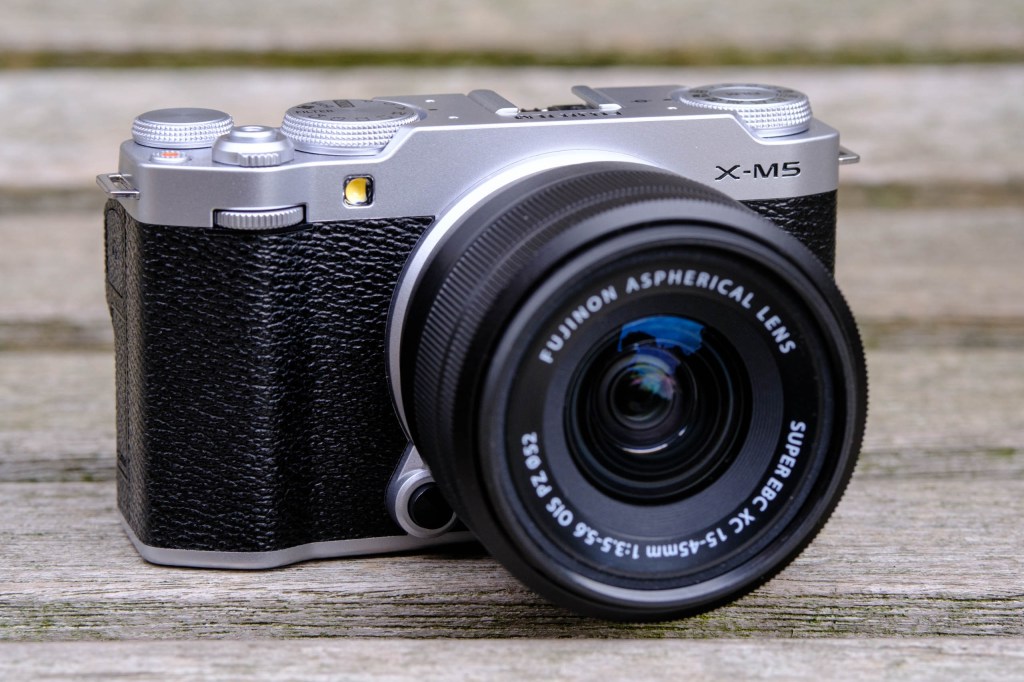
Amateur Photographer verdict
Although pocket-sized, the Fujifilm X-M5 is a vlogging beast. With 6.2K open-gate video and the option to shoot Full HD in vertical format, it’s a versatile shooter that handles nicely.- 6.2K open-gate video
- Terrific video features for the money
- Incredibly portable
- Balances poorly with big lenses
- No viewfinder
Specifications at a glance:
| Camera type | Mirrorless |
| Sensor | 26.1MP APS-C X-Trans CMOS 4 (BSI) sensor |
| ISO | 125 – 12,800 (standard), ISO 80 – ISO 51,200 (extended) |
| Video | 6.2K/30P, 4K/60p, 1080/240p video |
| Screen | 3in 1.04m-dot fully articulated touchscreen |
| Maximum recording time | 60 minutes |
The miniature Fujifilm X-M5 has shaken up the vlogging camera market, offering high-end features like 6.2K open-gate video (meaning it uses the full width of the sensor), optical stabilisation and intelligent subject-recognition autofocus, all in a pocket-sized body that costs just $799 / £799.
Making use of Fujifilm’s 26.1MP X-Trans 4 sensor, the X-M5 produces video of gorgeous quality. You can make use of Fujifilm’s famous Film Simulations for shooting video – they’re not quite full-on LUTs, but they look great. Having 7-stop effective in-body image stabilisation (IBIS) in a camera at this price point is also brilliant, particularly if you haven’t been able to budget for a gimbal.
The X-M5 is not perfect for all situations – those who also want to use it for stills will miss the viewfinder that can be found on the larger and more expensive Fujifilm X-S20, and its tiny body can feel quite unbalanced when used with large lenses. But otherwise, the sheer value for money offered here is exceptional, making the X-M5 an outstanding choice for vloggers.
Read our full Fujifilm X-M5 review
Best mid-range 4K
Best mid-range 4K vlogging camera: Sony ZV-E10 II
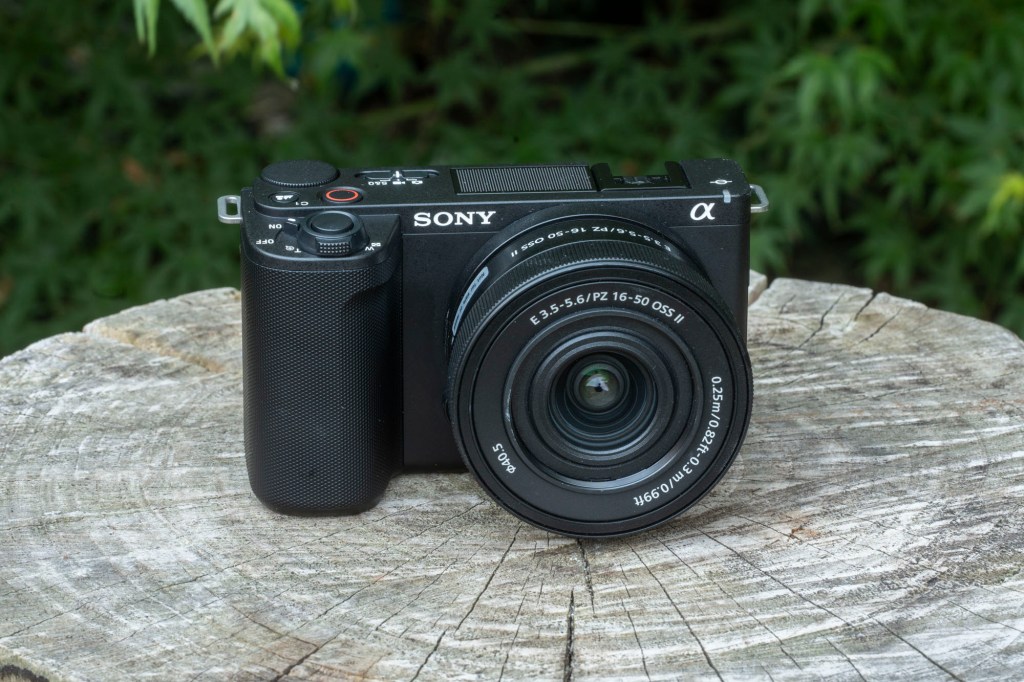
Amateur Photographer verdict
While the price hike from the ZV-E10 is an undeniable (if inevitable) wrench, the Sony ZV-E10 II raises the game for filmmakers with LUT support and an improved battery.- LUT support for filmmaking
- Focus Breathing Compensation
- NP-FZ100 battery improves longevity
- No physical sensor stabilisation
- No auto-framing functionality
Specifications at a glance:
| Camera type | Mirrorless vlog camera |
| Sensor | 26-million-pixel APS-C Exmor R CMOS sensor |
| ISO | ISO 100-32000 (standard), 100-102,400 (extended) |
| Video | 4K 60fps, Full HD 120fps |
| Screen | 3in articulated touchscreen |
| Maximum recording time | 130 minutes |
The original Sony ZV-E10 was the first mirrorless member of Sony’s vlogger-focused ZV line-up, allowing for the use of E-mount lenses. In July 2024, Sony released its successor; the ZV-E10 II. The good news is that it borrows its APS-C sensor from cine specialist, the Sony FX30. This enabled a slew of filmmaker-focused features for the new model. The bad news? You’ve guessed it – the ZV-E10 II costs much more than the original ZV-E10 – is it worth it?
The ZV-E10 II can capture 4K 4:2:2 10-bit All-Intra footage at 60fps, oversampled from 5.6K (or drop to 30fps to oversample from 6K). The footage looks brilliant, with 10-bit colour depth, and you can zhuzh it up as you like with Sony Picture Profile settings like S-Cinetone. More significantly though, the ZV-E10 II now has a LUT import feature, allowing you to import colour profiles as you see fit and apply them to your footage. As we said in our first-look review, this is a brilliant feature in particular for up-and-coming filmmakers who want to experiment with different looks and emulate the styles of their heroes.
Video autofocus is as excellent as we’ve come to expect from Sony – make sure to pair the camera with one of the best Sony lenses (it can be bought with an upgraded version of the serviceable PZ 16-50mm f/3.5-5.6 kit lens) to take full advantage of it. The improved battery also means better recording times than the original ZV-E10, while also necessitating a larger handgrip that adds a bit to the bulk, but makes the camera much more comfortable to hold. An acceptable trade-off, in our view.
This is an excellent mid-range vlogging camera for those who can afford it. For others, the original ZV-E10 represents excellent value for money.
Read our Sony ZV-E10 II review.
Best 4K MFT camera
Best Micro Four Thirds 4K camera: Panasonic Lumix GH7
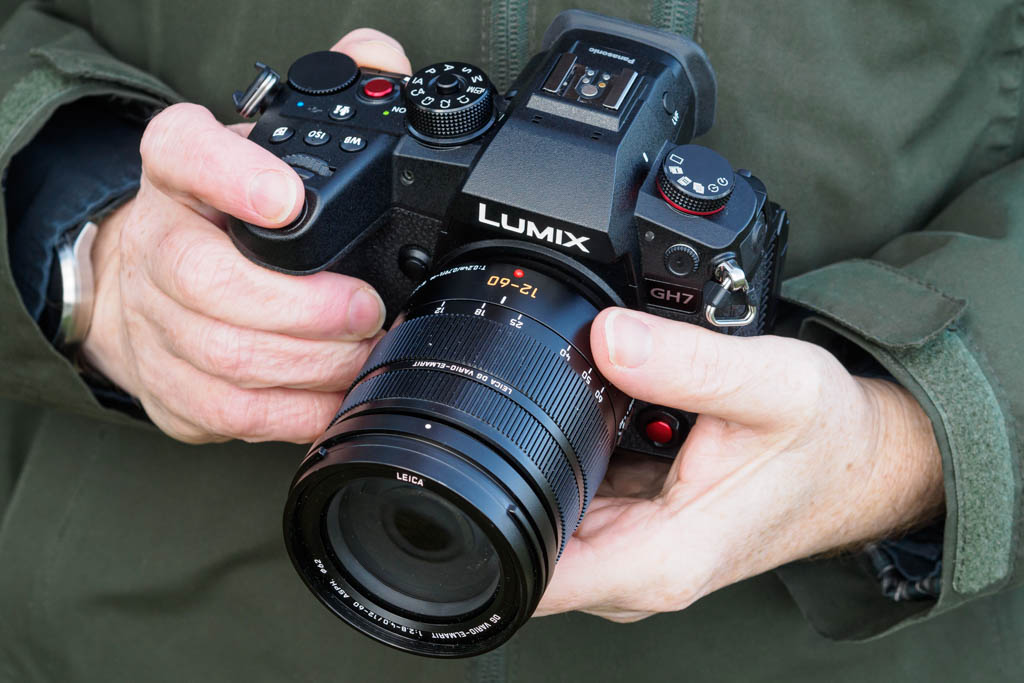
Amateur Photographer verdict
A superb hybrid camera for both stills and video. It offers the same excellent handling and advanced video features as the GH6, but gains significantly improved autofocus.- Vast range of video formats and high-end features
- Practically unlimited video recording times
- Superb in-body image stabilisation
- Transformed autofocus thanks to phase detection and updated subject recognition
- Excellent handling and control layout
- No automatic subject-type selection
- Lower dynamic range than larger-sensor cameras
- Slightly bulky body
Specifications at a glance:
| Camera type | Micro Four Thirds |
| Sensor | 25.2MP BSI-CMOS Four Thirds-type sensor |
| ISO | ISO 100-25,600 (standard) |
| Video | 5.7K 60fps, C4K 120fps, FHD 240fps video |
| Screen | 3in, 1.84m-dot fully articulated/tilting LCD |
| Maximum recording time | Unlimited recording time |
The Panasonic Lumix GH7 is the latest in the firm’s long-running line of video-centric Micro Four Thirds cameras. Fifteen years after releasing the original GH1 – the first ever mirrorless model capable of recording video – the GH7 finally gains the update that users have been requesting for ages: phase detection autofocus. This has had a transformational effect on the firm’s other recent cameras, so its inclusion in the GH7 is genuinely exciting and should make it one of the best Panasonic cameras yet.
The sensor includes Panasonic’s Dynamic Range Boost, which employs parallel readouts to deliver a promised dynamic range of 13 stops in both stills and video. This goes some way to alleviating one of the perceived disadvantages of the Micro Four Thirds sensor. However, this feature isn’t active when shooting at 60fps or faster, or at shutter speeds slower than 1/15sec.
For video, the GH7 offers a vast range of options in resolution, frame rate, aspect ratio, colour depth, encoding schemes and file formats. You can shoot anything from ‘open gate’ 4:3 aspect ratio 5.8K at 30fps, though 17:9 5.7K at 60fps and C4K at 120fps, to 16:9 Full HD at 240fps. If there’s any option in between you want to use, it’s sure to be available – Panasonic’s spec sheet lists no fewer than 160 possible combinations.
Read our review of the Panasonic GH7.
Best on a budget
Best cheap vlogging camera: Canon PowerShot V10
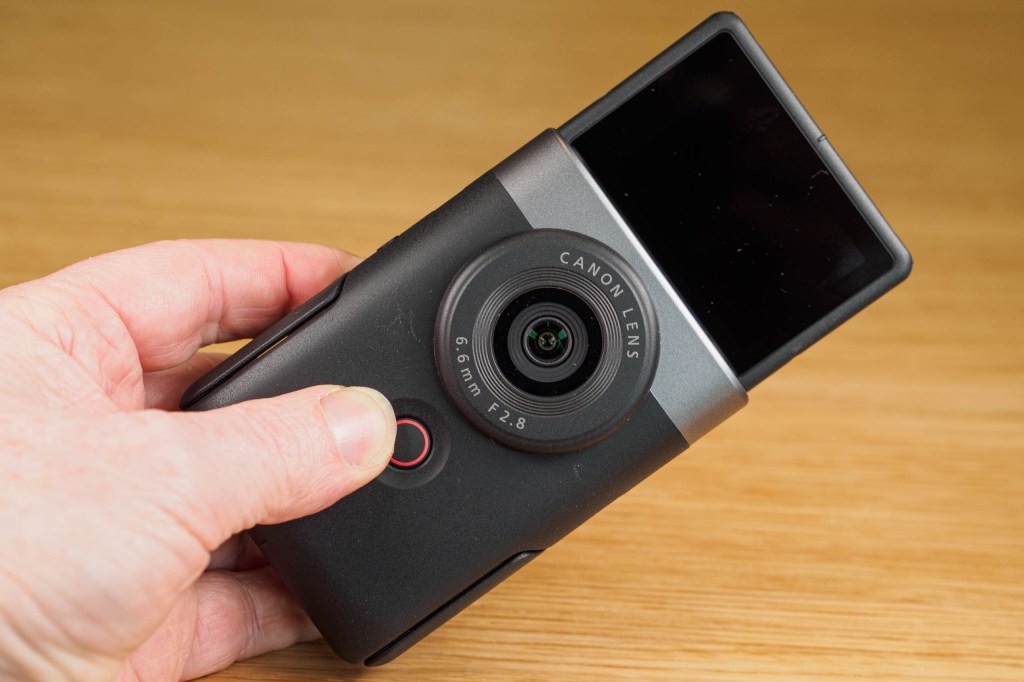
Amateur Photographer verdict
Quick to set up, easy to hold in one hand, or to use the built-in stand. But the lack of optical image stabilisation is a significant drawback- Design makes one-handed operation a breeze
- Lightweight, portable and affordable
- Wide lens is perfectly pitched for vlogging
- Significant recording limits in 4K
- Digital stabilisation only
Specifications at a glance:
| Camera type | Compact with 19mm equivalent f/2.8 lens |
| Sensor | 20MP 1-inch type sensor |
| ISO | 125-6400 for video, 125-12800 for stills |
| Video | 4K 30p video, Full HD 60p |
| Screen | 2inch tilting touch-screen |
| Maximum recording time | Up to 60 minutes |
The Canon PowerShot V10 immediately catches the eye. Shaped differently to a conventional camera, it’s currently something quite unique; an interesting innovation from Canon. Working on the assumption that conventional vlogging cameras are not particularly easy to hold in a front-facing orientation, even with flip-down or flip-around screens, the V10 fits in the palm of one hand, with a 19mm equivalent lens that makes it easy for the user to film themselves.
While it does shoot stills, this is a video camera first and foremost. It sits comfortably in the hand, the record button falls right under the thumb, and can record in Full HD 60p or up to 4K 30p – though as we found in our testing, the latter comes with some pretty brutal time limits due to overheating. The V10 weighs just 211g, and has a front-facing screen for easy monitoring – though anyone who’s used to recording on a modern iPhone or Samsung phone will probably find it jarringly small.
The experiment of the Canon PowerShot V10 is a partial success. Its custom form for hand-held vlogging certainly makes more sense than a conventional camera shape, which is awkward to hold in a backwards orientation. However, the stabilisation is digital, not optical: and while this will do for dealing with normal hand-held camera shake, it is seriously limited for use while walking. There are also a few operational oddities (why is it so fiddly to change frame rates?) that will likely be ironed out either in firmware updates or in the next model that comes along – assuming one does.
While not perfect, the Canon PowerShot V10 is a noble and interesting attempt, and is well worth investigating if you don’t want to film yourself with a conventionally shaped camera. Hopefully, there’s enough take-up to warrant Canon producing a PowerShot V20, as this is a promising idea that could use some refinement.
Read our Canon PowerShot V10 review.
Best for action
Best vlogging camera for action and adventure: DJI Osmo Action 5 Pro
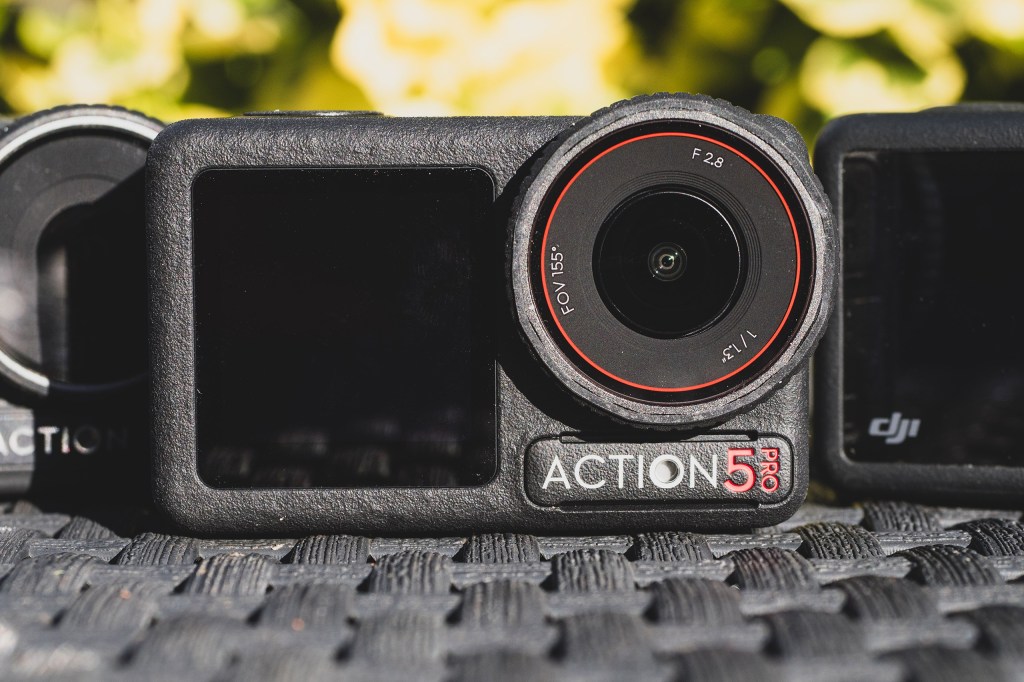
Amateur Photographer verdict
With GoPro-beating video quality, the DJI Osmo Action 5 Pro is the new standard to beat when it comes to action-packed vlogging.- Brilliant video quality
- Hardy, waterproof build
- Connects to DJI MIc
- 47GB internal storage
- No 5.7K
- Lacks GoPro’s modular lenses
Specifications at a glance:
| Camera type | Action camera |
| Sensor | 40MP 1/1.3 inch sensor |
| ISO | Photo: 100-25600, Video: 100-51200 |
| Video | 4K 120p |
| Screen | Dual OLED High-Brightness touchscreens |
| Maximum recording time | 240 minutes |
While GoPro is undoubtedly the more famous name in action cameras, the DJI Osmo Action 5 Pro is for our money the best pick for action-packed vlogging. It’s ruggedly waterproof, it records brilliant-looking 4K, it runs for up to 240 minutes, it captures 10-bit D-Log footage, it boasts that brilliant Rocksteady stabilisation – it’s a comprehensively featured camera for action and extreme sports.
It’s a significant jump over the previous Osmo Action 4, as our reviewer discovered when testing footage from the two cameras side by side. Some might wish that DJI could have included 5.7K video, but in truth 4K is plenty for most vlogging purposes. It lacks the modular lens system of the later GoPro Hero cameras, though a cynic might observe that these mostly seem to exist to provide consumers with more opportunities to give GoPro money.
The stabilisation is good as mentioned, though not a patch on the gimbal stabilisation offered by the DJI Pocket 3 – that’s the camera to pick is smooth movement is a higher priority for you than a waterproof build. However, for adventurous shooting opportunities like surfing, skydiving, mountain biking and the like, the DJI Osmo Action 5 Pro is top of the pile right now.
Read our full review of the DJI Osmo Action 5 Pro.
Best full-frame 4K
Best full frame video camera for 4K: Panasonic Lumix S5 II
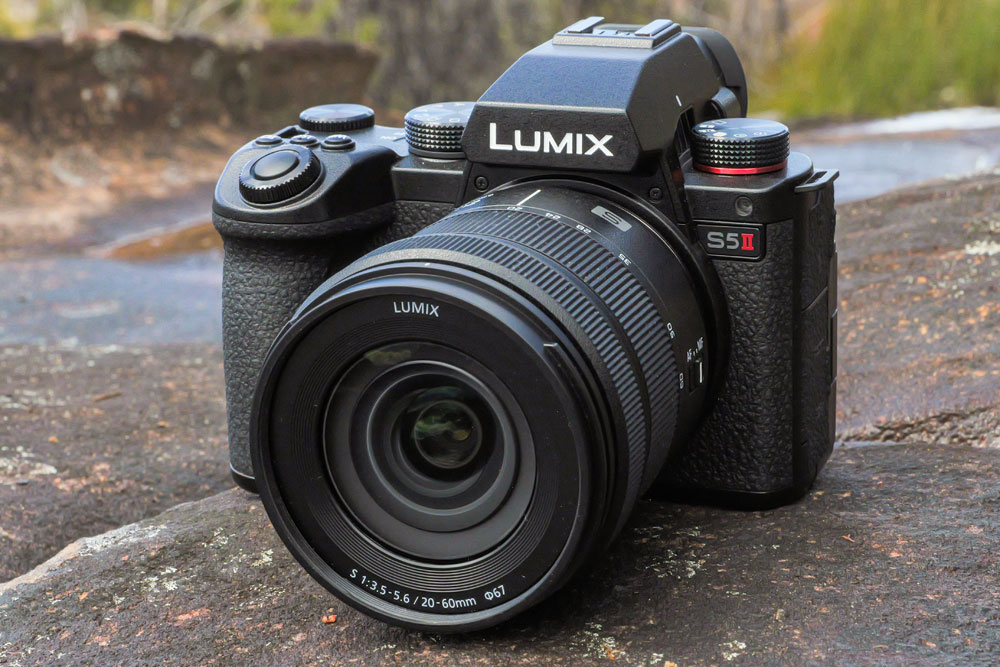
Amateur Photographer verdict
Phase detection and unlimited video recording are two key features sure to appeal, alongside an excellent viewfinder and screen and effective image stabilisation- Smart, fast autofocus system
- Excellent video quality and options
- Integrated cooling fan
- Default setup under-uses control dials
- Metering errs towards underexposure
Specifications at a glance:
| Camera type | Mirrorless |
| Sensor | 24.2MP full-frame sensor |
| ISO | ISO 100-51,200 (standard) |
| Video | 6K 30p, C4K 60p |
| Screen | 3.0″ 1.84m-dot LCD |
| Maximum recording time | 30 minutes. 6K/30p, Unlimited 6K/25p |
Starting 2023 with a bang, Panasonic unveiled an updated full-frame mirrorless camera we’d long been waiting for – a Lumix model with phase-detection autofocus. That’s right, the trusted but dated contrast-detect Depth from Defocus system was finally cast away into the annals of history. The Lumix S5 II is all the better for it. It’s so much faster than previous Lumix S cameras, in both video and stills.
While full-frame cameras from Sony et al climb vertiginously in price, Panasonic is being canny in keeping this model below the $2000 / $2000 mark. It makes for a hugely compelling option for vloggers and videographers with a budget, but not the funds commanded by the likes of the Sony A7S III or the Sony A1.
As we noted in our review, the flexibility and versatility offered by the Lumix S5 II for video is simply staggering. And thanks to a clever built-in fan mechanism, it can effectively record indefinitely without overheating (which feels like a response to the much-publicised heating travails of the Canon EOS R5). You’re really only limited by card space or battery power, which is great for a hard day of intense recording.
The aforementioned autofocus system also benefits from the must-have feature in all new cameras – subject-detection that can recognise humans and animals and lock onto them. The in-body stabilisation is rated up to five stops of compensation, and the Lumix S5 II can output 6K 30p video in addition to its suite of 4K options.
Without a doubt, this is a highly capable vloggers’ and videographers’ camera, ideal for shooting in pristine 4K.
Read our full Panasonic Lumix S5 II review
Best cinema camera
Best filmmaking camera: Blackmagic Pocket Cinema 4K

Amateur Photographer verdict
Ideal choice if you are serious about video quality and want a filmmaking camera with high dynamic range that shoots anamorphic footage- Very impressive dynamic range
- Mini XLR input
- ProRes and Blackmagic RAW formats
- A more expensive option
- Some may prefer a larger sensor
Specifications at a glance:
| Camera type | Mirrorless |
| Sensor | Four Thirds Sensor |
| ISO | ISO 100-25,600 (movie mode) |
| Video | 4K 60fps, Full HD 120fps |
| Screen | 5inch touchscreen display |
| Maximum recording time | No time limit |
The Blackmagic Pocket Cinema 4K could be a great first camera for aspiring filmmakers. While affordable, it has many advanced features prioritising image quality above all else.
It features a Four Thirds size sensor that has an impressive 13-EV of dynamic range so that you can capture lots of highlight and shadow detail. It can also save footage in ProRes or Blackmagic Raw 2.0 formats, meaning a considerable amount of colour detail is captured to enable image editing in post-production.
The Pocket Cinema 4K can record footage in 4K DCI (4096 x 2160) at 60fps or the even wider 4K 2.4:1 format (4096 x 1720) at 70fps. The camera can also shoot 2.8k anamorphic footage at 80fps. Those that want slow-motion footage can shoot at 120fps in Full HD resolution.
The Micro Four Thirds lens mount means that there is a vast amount of quality lenses, new and used, at affordable prices. However, there is no sensor or digital stabilisation. The Pocket Cinema 4K relies on any optical lens stabilisation, so it is better suited to being on a tripod or gimbal than being used handheld. Autofocus isn’t the fastest, so it suits a more static environment where you can manually focus a lens on a subject.
The Pocket Cinema 4K features a substantial 5-inch touchscreen perfect for navigating menus, focusing precisely, composing your shot and reviewing your footage.
As a fully-fledged cinema camera for filmmakers, the Pocket Cinema 4K has all of the inputs and outputs you would expect and some you might not. There are slots for CFast or SD cards to be used for storage, and you can even record directly to an SSD via the USB 3.1 port. For audio, there’s a 3.5mm mic input and a Mini XLR input for professional microphones that require phantom power. It also allows you to monitor the audio via a 3.5mm headphone jack.
It may seem overkill to have such a powerful camera for shooting YouTube, yet for its price, it offers the best image quality for those recording reviews or demonstrations. It is also the perfect entry point for anyone that wants to begin a career in filmmaking.
Best for beginners
Best vlogging camera for beginner YouTubers: Nikon Z30
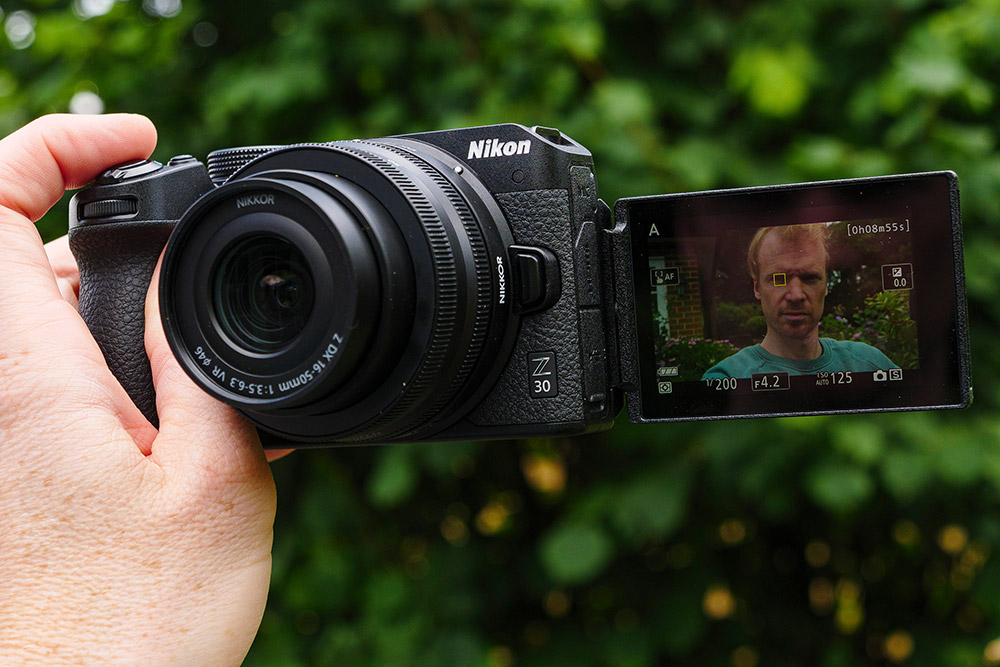
Amateur Photographer verdict
The Z30 aimed at vloggers brings lovely image quality at a compelling price point. All-in-all the flip touch screen, wide-area continuous AF, tally lamp, make for a good shooting experience- Long recording times
- Useful vari-angle screen
- Lightweight, but high-quality
- No viewfinder
- No headphone socket
Specifications at a glance:
| Camera type | Mirrorless |
| Sensor | 20.99-million-pixel APS-C CMOS Sensor |
| ISO | ISO 100-25,600 (movie mode) |
| Video | 4K 30fps, Full HD 120fps |
| Screen | 3in 1.04m dot vari-angle touchscreen |
| Maximum recording time | 125 minutes |
The Nikon Z30 is a small, affordably priced entry point to Nikon’s Z system. Designed and marketed as a vlogging camera, it has a great basic set of features. It does lack a few headline features – for instance, there is no sensor-based stabilisation, although Nikon does have optically stabilised lenses. A good one is the NIKKOR Z DX 16-50mm f/3.5-6.3 VR, which is available in a kit with the Z30 for around $750 / £840. There is also eVR, or Electronic Vibration Reduction, which is Nikon’s form of digital stabilisation for video. For more, check out our picks of the best Z-mount lenses for Nikon in 2025.
All the features you expect for getting started with vlogging are present, including a vari-angle screen for recording yourself, and a microphone socket. There is no headphone socket for monitoring audio. Still, there are other great features, including a recording time of up to 125 minutes (battery-dependent). The camera uses the entire width of the 20.99-million pixel sensor to shoot 4K without any crop.
Although it lacks some of the more advanced features and recording options of other cameras in this line-up, its price makes it a significant step up for those shooting with a smartphone or compact camera.
Read our full Nikon Z30 review.
Best weather-sealed
Best weather-sealed compact mirrorless camera: OM System OM-5
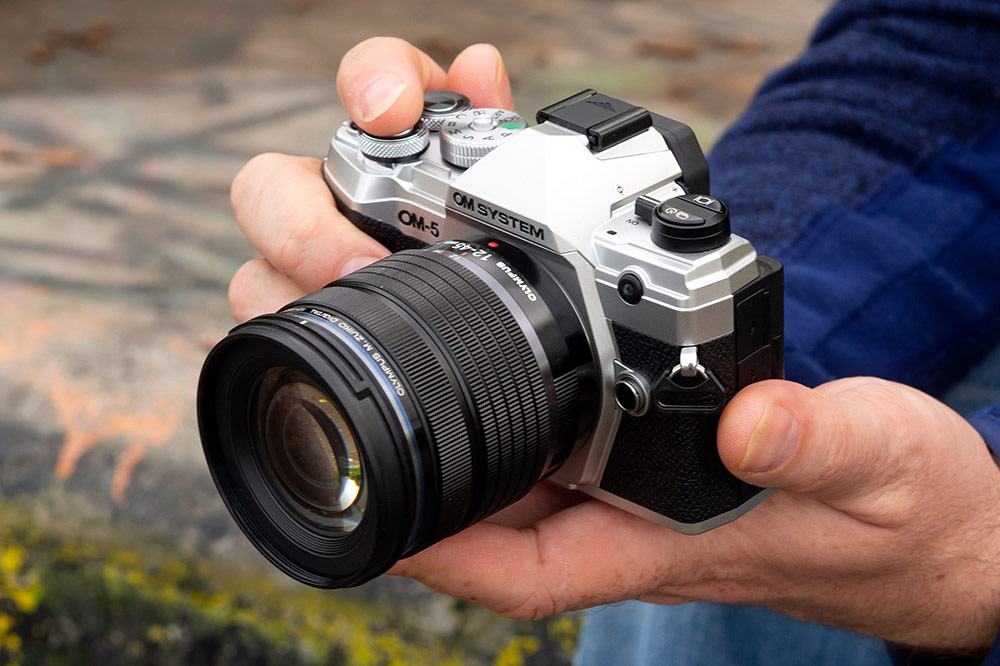
Amateur Photographer verdict
With an unmatched lens range, we love this versatile and impressive camera which has features that are great for hybrid shooters- EVF and vari-angle screen
- Excellent lens choice
- Superb stabilization
- More expensive than budget vlogging cameras
- Not the most advanced for video
Specifications at a glance:
| Camera type | Mirrorless |
| Sensor | 20.4MP Four Thirds sensor |
| ISO | ISO 200-6400 (extended: L64-25600) |
| Video | 4K 30p video, 120p full HD |
| Screen | 3inch, 1.04m-dot vari-angle LCD |
| Maximum recording time | No time limit |
The OM System OM-5 is essentially a refresh of the Olympus OM-D E-M5 Mark III; which was an excellent camera already. It’s a Micro Four Thirds model that uses a somewhat smaller sensor size than APS-C cameras, yet is very popular in the video community. It is also used in Panasonic’s highly regarded Lumix G cameras, like the Lumix GH6, and the new GH7.
The OM-5 is not designed specifically for video – its video features can pretty much be matched by cheaper alternatives. The difference is that it has an electronic viewfinder and fully articulating rear screen, along with some very powerful stills photography features that make it perfect for those who need to produce both still photographs and video with the same kit; perhaps swapping from one minute to the next.
The in-body image stabilisation is about as good as it gets, and while the video capture tops out at 4K 30p, you can shoot at up to 120p in full HD resolution. The E-M5 also comes with a built-in log profile for those who need to carry out some more advanced colour grading later on.
Perhaps the key characteristics of the OM-5 for vlogging are its small size, its robust weather-proof construction and the wide choice of both zoom and prime lenses available, which are typically smaller and lighter than those for APS-C or full frame cameras.
Read our full OM System OM-5 review
Best APS-C
Best Canon APS-C camera for vlogging: Canon EOS R10
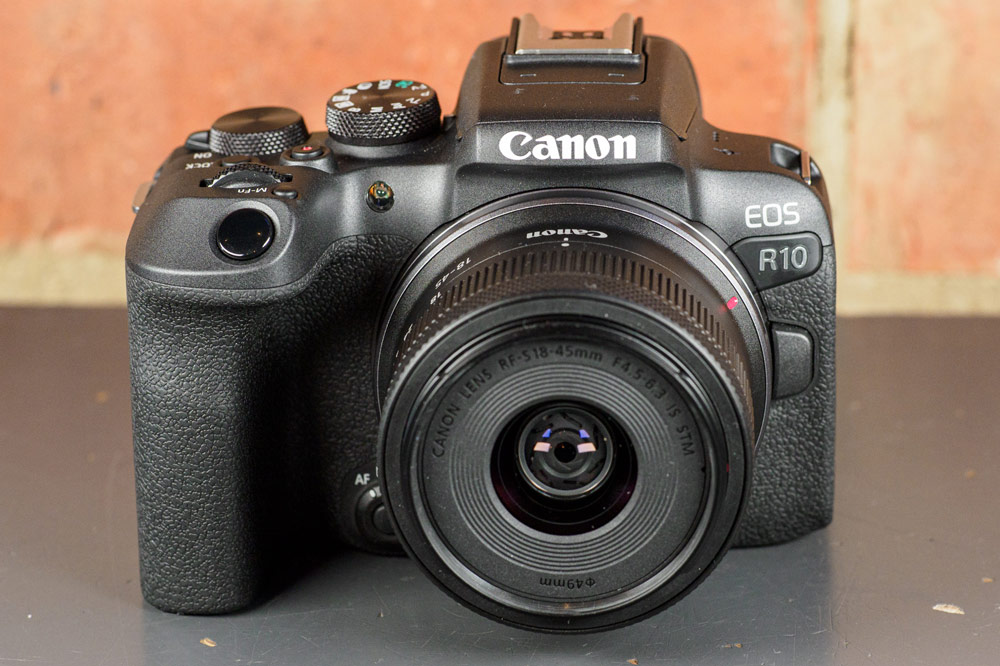
Amateur Photographer verdict
A great choice for entry-level, it handles nicely and the autofocus system is superb especially considering its price point- Compact size and light weight make it easy to carry
- Excellent control layout and handling, especially given the small size
- Subject detection autofocus works very well
- Viewfinder is disappointingly small
- No in-body image stabilisation
- Limited native APS-C RF-S lens range
Specifications at a glance:
| Camera type | Mirrorless |
| Sensor | 24.2MP APS-C sensor |
| ISO | ISO 100-51,200 |
| Video | 4K 30p video |
| Screen | 3in vari-angle LCD |
| Maximum recording time | Up to 120 minutes |
If you’re making your first step up to mirrorless from a smartphone, the Canon EOS R10 is one of the smartest choices you can make. As we found out when we subjected the camera to a full test and review, the EOS R10 is impressively feature-packed for a sub-$1,000 / £1,00 camera.
It’s lightweight, it’s easy to use, and there are a fair few smart features that should endear it to vloggers. A small but welcome thing – the video record button is prominently situated in just the right place on the top plate where it’s easy to press while pointing the camera back towards yourself at arm’s length. The 3in, 1.04m-dot fully articulated touchscreen has a side-hinged design that make it easy to flip forward to face yourself.
There have been some cutbacks to make the camera as small and affordable as it is (compared to the rest of the EOS R series, at least). The one that will most affect vloggers is the lack of in-body image stabilisation, which means you’re reliant on lens-based IS (which can’t correct for roll around the lens axis) or Digital IS (which incurs a 1.1x or 1.4x crop on your footage). Neither solution is ideal. Other than this small niggle though, the EOS R10 is a well-priced and well-balanced vlogging option.
Read our Canon EOS R10 review.
Additional budget and beginner vlogging cameras to consider
The team at AP tests and reviews loads of vlogging cameras – more than we could comfortably fit into this guide! If you’re on a budget, or a beginner, here are a few extra wallet-friendly and beginner friendly options that our review team think are particularly worth your consideration.
Best vlogging camera for beginners: Panasonic Lumix G100 with 12-32mm lens
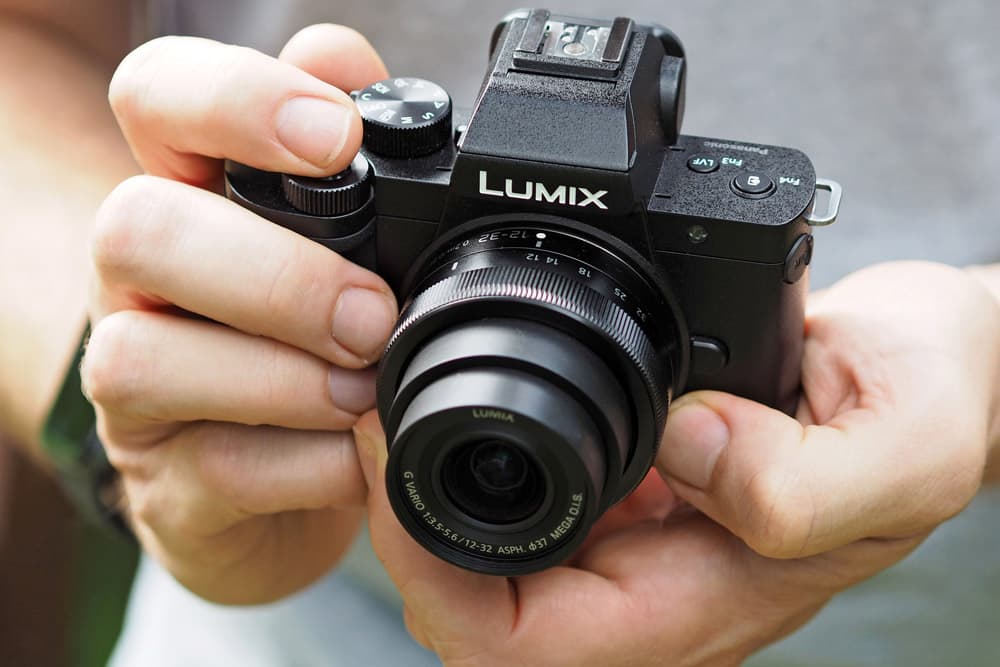
Amateur Photographer verdict
Image quality for both stills and video is good, while nothing revolutionary. The crop when shooting stabilised 4K footage will deter some people.- Impressive Audio
- Impressive EVF
- Good price point
- Heavy Crop in 4K with electronic stabilisation
- Slightly more noise compared to APS-C competitors
- 10min record time when shooting 4K
Specifications at a glance:
| Camera type | Mirrorless |
| Sensor | 20.3MP Four Thirds sensor |
| ISO | ISO100-ISO25600 available (extended) |
| Video | 4K30p |
| Screen | 3in 1.84M dot vari-angle touchscreen |
| Maximum recording time | 10 minutes in 4K, 20 minutes Full HD 60p, 30 min Full HD 30p |
Panasonic designed the Panasonic Lumix G100 (read our review here) with vlogging specifically in mind. Consequently, it has a 3-inch 1.8M-dot vari-angle touchscreen that can be flipped around to face forward and OZO Audio tracking by Nokia. The latter can work in tandem with the camera’s face-detection system to track a subject around the frame and decide which of the three internal microphones to use. The microphones can also be set to Auto, Surround, Front or Back depending upon where the most important sounds are coming from. It works well provided that there’s no wind around but there’s also a 3.5mm mic port.
Other nice features include a Rec Frame Marker, that shows the framing for different aspect ratios to help you to compose footage for a variety of platforms including Instagram stories; in-body stabilisation; and V-Log L that produces low-contrast, low-saturation footage.
As well as making the footage more gradable, it’s easier to match it to video from other cameras. There’s a slight crop applied to 4K footage on top of the 2x focal length magnification factor caused by the G100’s Four Thirds type sensor. That means that the 12-32mm lens actually looks a little longer than the 24-64mm effective length that it is for stills photography. However, it’s just about okay for handheld vlogging, especially if you mount the camera on Panasonic’s optional DMW-SHGR1 Shooting Grip. Angela Nicholson.
Best budget vlog camera: Canon PowerShot G7 X Mark III

Amateur Photographer verdict
The Canon PowerShot G7X Mark III is a lovely pocket camera that will give you more advanced control and better results than a smartphone.- Very good image quality
- Plenty of useful features
- Small, light and easily pocketable
- Capable of 4K video capture and YouTube live streaming
- Display can be hard to see clearly in bright sunlight
- Touchscreen could be fiddly for larger fingers
Specifications at a glance:
| Camera type | Compact camera with 24-100mm equiv f/1.8-2.8 lens |
| Sensor | 20.1MP 1.0 type stacked CMOS |
| ISO | ISO 125 – 25,600 (extended) |
| Video | 4K 120p |
| Screen | 3in 1.04M dot tilting touchscreen |
| Maximum recording time | 30 minute in HD, 10 minute in 4K |
The Canon PowerShot G7 X Mark II was a surprise success amongst YouTubers, so for the Mark III version, Canon made vlogging a key focus. Consequently, the Canon PowerShot G7X Mark III can shoot 4K (3840 x 2160) video at 29.97/25fps without cropping. That means when you get the full width of the 24-100mm (equivalent) stabilised lens, which is important if you’re holding the camera at arm’s length and pointing it towards yourself.
Further good news is that the maximum aperture range is f/1.8-2.8, which enables some blurring of the background when you shoot wide open. Handily, there’s also a 3-stop ND filter built-in that helps you to use the widest apertures in bright conditions. A collection of autofocus modes enables you to get the subject sharp. Significantly, these include Face Select and Track which works well in video mode, putting a box around your face when spotting you. You can see this as the 3in 1,040,000-dot touchscreen tilts up through 180° making it visible from in front of the camera.
There’s no viewfinder though. As usual, there’s Wi-Fi and Bluetooth connectivity onboard, but uniquely, the G7 X Mark III can live-stream direct to your YouTube channel. To do this, you need to create a free image.canon account, then input the relevant information and tap the connection details into your camera.
Then, provided that you have a decent Wi-Fi signal (or a hotspot from your network-connected smartphone), you’re free to stream. All of this would count for nothing if the PowerShot G7 X Mark III didn’t produce high-quality results but thanks to its 20.1MP 1in type stacked CMOS sensor, it delivers excellent stills and video. It has a sensitivity range of ISO 125-25,600, but ideally, keep to ISO 3200 or lower. Angela Nicholson.
Fujifilm X-S10 with 18-55mm lens

Amateur Photographer verdict
A joy to use. With superb APS-C sensor, IBIS, and lens range, the X-S10 reliably produces gorgeous images across a wide range of conditions – (and needs good care in bad ones as lacks sealing).- Fantastic image quality JPEG and raw
- Excellent control layout and handling
- Effective IBIS
- Fully articulated screen
- Lots of available lenses
- No weather sealing
- Remote release requires an adapter
- Value retained since release
Specifications at a glance:
| Camera type | Mirrorless X-mount |
| Sensor | 26.1MP APS-C X-Trans CMOS sensor |
| ISO | ISO 160-12,800; 80-51,200 (extended) |
| Video | 4K 30p |
| Screen | 3in 1.04M dots fully articulated touchscreen |
| Maximum recording time | 30 minutes |
Even though it’s an older camera, the mirrorless Fujifilm X-S10 is still widely available, and makes for a great choice for anyone looking for a slightly more budget-friendly route into vlogging on the Fujifilm X system. The X-S10 can be bought in certain territories as part of a ‘vlogger kit’, bundled with an XC 15-45mm lens, an SD card, a GorillaPod flexible tripod and a RØDE shotgun mic – all of which will set you up nicely to get started with vlogging.
The X-S10 is one of the more affordable Fujifilm cameras, but it still packs in plenty of vlogger-friendly features like a fully articulating rear screen, a pretty respectable IBIS system that provides up to 5.5 stops of compensation, a 3.5mm mic slot and the ability to plug in monitoring headphones via the USB-C connection. It shoots 4K 30p video that looks excellent straight out of camera, benefiting from Fujifilm’s excellent colour science.
Subsequent cameras like the X-M5 featured above are unquestionably the better option for video, with 6.2K 30p for a starter, as well as longer recording times and AI-powered subject-detection autofocus. However, all this inevitably comes at a cost – and you could save cash getting a second-hand X-S10. Either way, you’re getting a mirrorless camera that’ll produce punchy and vibrant footage, and the X-S10 is definitely worth considering as an introduction to vlogging on the X system. Jon Stapley.
Frequently asked questions
Here are the key specs to think about when selecting your camera for vlogging, videography, and YouTube.
FAQ: What resolution do I need?
One of the first things to look for is video resolution. Nearly every camera on the market should be shooting at 4K resolution. 4K televisions and screens are commonplace, and we are starting to see cameras that will shoot in 8K or higher. If you are beginning to vlog or shoot for YouTube, however, there is currently no real need for you to be shooting in 8K; it is complete overkill.
Do you even need 4K for social media? Probably not, since a lot of social video is shared at full HD 1920 x 1080 resolution. However, shooting in 4K does allow you to crop for any social media platform and will give you editing flexibility later.
FAQ: What frame rate should I use?
Frame rate is how many images, or frames of video, the camera can record in a second. The more frames, the smoother the footage, and it also allows you to slow the footage down without it looking jerky. Hollywood movies are typically shot at a frame rate of 24fps, whilst PAL TV is 25fps with the US NTSC format at 30fps. Higher frame rates are a multiplier of these, so you will commonly find 50fps and 60fps and 100 and 120fps.

By recording at 120fps and then creating a video that is shown at 30fps, you will have a 4x slow-motion effect. So, if you are interested in shooting slow-motion footage, the higher the frame rate, the greater the slow-motion effect. For an excellent slow-motion effect, look for at least 120fps.
FAQ: What kind of stabilisation do I need?
If you are shooting cooking or craft tutorials, you can use a tripod. For more on how to choose the best tripod for you, check out our ultimate guide to tripods as well as our picks for the best tripods to buy. However, if you are using the camera handheld for vlogging or filmmaking on a family holiday, un-stabilised video can look shaky and almost unwatchable.
Lens or sensor-based stabilisation will help keep the footage looking steady. Some cameras will also use digital stabilisation. Digital stabilisation crops into the frame and shifts the recorded area to smooth camera movements. A combination of all three types of stabilisation can keep handheld footage free of all but the most dramatic of movements.
For cameras that don’t have stabilisation, a motorised three-axis stabiliser, also known as a gimbal, is a great way to create smooth footage.
FAQ: Do I need a microphone for better audio?

People often say that poor footage can be forgivable, but poor audio can make a video unwatchable. For the most part, this is true. While you’ll be hard-pushed to find a camera that doesn’t have built-in microphones for recording audio, these will only be fine in ideal conditions, such as in a quiet environment.
For the best possible audio, using an external microphone is a must. Make sure your camera has a microphone input socket, which will usually be a 3.5mm socket on the side of the camera. This socket will allow you to add a microphone, which will usually be held on an accessory shoe on top of the camera. However, be aware that this may block or hinder the use of a front-facing screen.
FAQ: What about the screen?
If you are planning on filming yourself, you will need to look for a camera that has a screen that can be turned so that it faces you whilst you are recording. Generally, these come in two types – articulated from the side or flipping up from the top. Both have their advantages.
Top-facing screens look more natural if you look at the screen rather than the front of the lens. However, if you want to mount a light or microphone to a hot-shoe, it may prevent you from using the screen. Side-facing screens will leave the camera’s top free for mounting microphones and accessories. Still, if you find yourself presenting to the screen, it can look unnatural as your eye-line will always look off to the side. In summary, remember to talk to the lens, not the screen!
For those who aren’t filming themselves, a simple tilting articulation helps shoot at different angles, making your videos look more dynamic. If you find the screen on the camera too small, then you can look at external camera screens or alternatively some phones like the Sony Xperia Pro can be used as external monitor.
FAQ: Power and battery
Shooting a video can drain a battery very quickly. While battery life shouldn’t be a deciding factor when buying a camera, it is worth noting so that you can plan to purchase an additional battery, or two or three, if you are out shooting video all day.
Something else is to look for charging. Most cameras will charge through a microUSB or USB-C connection, with many of these also able to be powered by USB whilst still recording. A simple USB power bank could give you hours more recording by either keeping the battery charging when not in use or by being able to power your camera, though be aware that some cameras need newer USB Type C PD (power delivery) which is found only on newer/better power banks.
FAQ: What about sensor size?

As in photography, the sensor is probably the defining feature of a video camera. As a (very) general rule, the larger the sensor, the better the image quality will be. A full-frame sensor will have a greater dynamic range, lower noise levels and better image quality at higher ISO sensitivities than a smaller sensor of the exact resolution.
So, shooting with a camera with a full-frame sensor will produce better results than shooting with the smaller sensor of a smartphone. The downside is a larger sensor will mean a bigger camera and larger lenses, which may not be ideal if you want something small for vlogging. See our guide to APS-C vs full-frame sensors for more on the differences between the two, or take a look at: Does sensor size matter for video?
FAQ: What lens do I need for video?
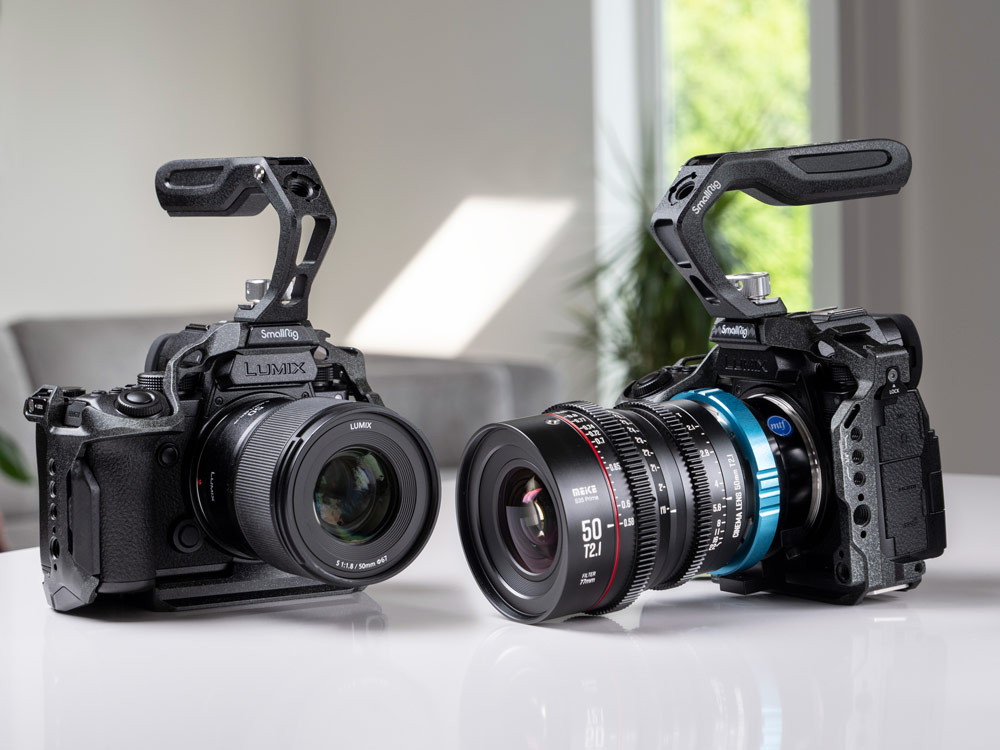
Depending on your vlogging and video needs and of course your budget, you either look for a zoom lens that will cover everything, or a variety of fast primes and zoom lenses that you can swap between. If you are shooting solely video content you might consider swapping for cine lenses. However, whether you really need a cine lens to shoot video, is another question.
It should go without saying that a fast aperture lens will allow you to capture beautiful shallow depth of field shots and a cinematic style.
Some important points to keep in mind are: the size focus ring for better grip and more nuanced focus control, a de-clicked aperture ring to balance exposure more easily, IS-lenses with built in stabilisation, advanced coating to deal with high contrast scenes, and a fast and quiet motor to be able to keep up with movement.
Read our detailed tips on what makes a good lens for video in our guide to the best lenses for video.
How we test cameras
We test cameras primarily by using them to take photographs and video in a wide range of real-world situations. We evaluate their control layouts and handling, and the usability of their viewfinders and screens. We assess their autofocus across a range of different subjects and shooting scenarios.
We also examine the effectiveness of their image stabilisation systems. Last but by no means least, we critically evaluate the video quality including resolution, high-ISO noise, and dynamic range. We then take all these factors into account, along with such things as portability and lens systems, when giving our final conclusion and score. You’ll find the full breakdown of how each camera has performed in our full reviews.
Text by Richard Sibley, with contributions from Jon Stapley, Angela Nicholson.
Finished with our guide to the best cameras for video? Don’t miss our in-depth guides to shooting video, including 9 common video problems and how to fix them, as well as our no-nonsense guide to how to get outstanding audio in your videos.
Further reading:
- Best smartphones for video
- Best accessories for video
- Best camera phone accessories for photography and video
- Best vlogging tips and how to get started

